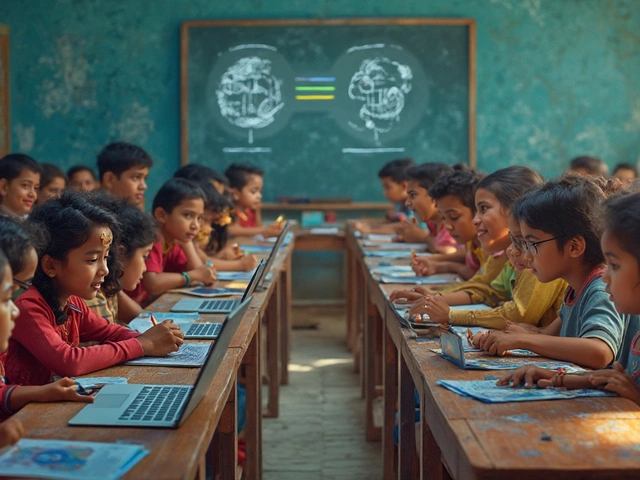Picture this: You’re a parent thinking about your child’s future, or maybe you’re an uncle like me who always ends up fielding those awkward education questions at family gatherings. Whichever side you’re on, you’ve probably heard about CBSE schools in India. They crop up in every other conversation about good education, and with good reason. CBSE (Central Board of Secondary Education) isn’t just a board—it’s almost a badge. Parents love that it’s recognized across India and even outside the country. That’s why you’ll spot CBSE schools in almost every corner of the map, from mountain towns in the north to seaside spots down south.
But, here’s the twist: with 3/4ths of conversations revolving around “the best school” and “CBSE or state board?”, have you ever wondered which state actually has the maximum number of CBSE schools? Go ahead, make a guess. Uttar Pradesh? Maharashtra? Karnataka? You might be surprised. The numbers do not always reflect the population or size of the state. Instead, they often reveal a lot about migration, competition, and how value-driven a place is towards education. So, let’s break down the facts, look at the trends, and uncover the unexpected champion in this academic race.
The Big Numbers: Which State Tops the CBSE School Count?
Let’s get straight to it: Uttar Pradesh holds the crown for the highest number of CBSE-affiliated schools in India. It’s a stunner, given that the state is also the most populous in the country, but the numbers really are massive. As of the latest official data from the CBSE (2024), Uttar Pradesh boasts over 4,500 CBSE schools. To give you context, the nationwide count tips over 27,000 CBSE schools across India. That’s about one out of every six CBSE schools being in Uttar Pradesh alone. Crazy, right?
To make things more interesting, here’s a table showing the leading states and their number of CBSE schools, using the publicly available stats for 2023-2024:
| State | Number of CBSE Schools |
|---|---|
| Uttar Pradesh | 4,500+ |
| Maharashtra | 2,300+ |
| Rajasthan | 2,100+ |
| Karnataka | 1,700+ |
| Tamil Nadu | 1,550+ |
| Delhi (NCT) | 1,250+ |
| Bihar | 1,200+ |
| West Bengal | 1,160+ |
| Madhya Pradesh | 1,100+ |
| Kerala | 960+ |
While Uttar Pradesh leads, Maharashtra and Rajasthan are racing behind, and there’s a massive drop after the top five. Delhi, though not a large state, stands out because of its population density and the sheer preference for CBSE in India’s capital. If you look at a map, these schools cluster tightly around major cities and tier-2 towns—think Lucknow, Agra, Pune, Jaipur, Mysuru, and Chennai.
So, why does Uttar Pradesh have such dominance? Being the most populous state obviously helps, but there’s more. With cities like Noida and Ghaziabad practically on Delhi’s doorstep, there’s a strong middle-class drive towards competitive exams, and CBSE boards are seen as the best prep for those. Plus, the spread of the board over rural and semi-urban areas in Uttar Pradesh is something you don’t always see in, say, Kerala or Assam, where either state boards or other central boards are preferred. Parents in Uttar Pradesh want portability—if the family needs to move, their child can slot back into any other CBSE school across the country with zero stress.
One more thing: Not every CBSE school is cookie-cutter. The range is wild. There’s everything from posh international-style campuses with Olympic-sized pools to no-nonsense schools focusing on old-school discipline in small market towns. The brand is strong because of the curriculum, stability, and standardization, but every state has its own flavor of CBSE education. For example, CBSE schools in the tech cities of Pune or Bengaluru may have a sharper focus on science and coding, while those in the north might have a bilingual approach with richer local language options.

Why the Surge? What Drives States to Open More CBSE Schools?
The CBSE explosion started in the 80s and 90s, but the real boost came post-2010 when mobility and job migrations went through the roof. Let’s think about this: Kids of government employees, defence staff, and IT professionals needed a school whose syllabus didn’t throw them off-guard during a move. CBSE ticked all the right boxes—consistent curriculum, English and Hindi mediums, and wide exam acceptability for things like JEE and NEET (the two monsters of Indian entrance tests).
Uttar Pradesh, leading the race, puts the spotlight on an interesting trend—families moving to NCR suburbs (like Noida or Greater Noida), where every new residential block advertises “close to a top-rated CBSE school.” Maharashtra, especially around Pune, Mumbai, and Nagpur, is similar. Parents see CBSE as the safer bet; its board exams are rarely unpredictable, and the NCERT books are the kind you can actually buy at every second bookstall in India.
Another big reason? Results. Have you ever noticed how many of those “All-India Topper” stories in newspapers come from CBSE schools? It’s not a coincidence. The board tailors its exams to reward conceptual learning over rote memorization (well, at least more than some state boards). That’s a massive attraction for ambitious families aiming for IITs, AIIMS, or foreign universities. Even my cousin in Chennai, who dreaded the move from a state board to CBSE, ended up loving how the curriculum made her feel less like a robot and more like a student being prepped for the real deal.
Let’s not overlook the government’s own efforts. Since 2017, the Ministry of Education has been nudging schools—especially in underserved states—to join the CBSE network because it makes regulation, scholarship eligibility, and even teacher recruitment easier. This government push is why you’ll notice more Kendriya Vidyalayas and Jawahar Navodaya Vidyalayas, both under CBSE, cropping up in small towns and semi-urban districts. The CBSE umbrella covers private giants, public schools, and even a growing number of international schools that want the credibility of an Indian central board with a slightly global twist.
Parents also tell me (and this goes for my neighbor Meera in East London who wants to send her niece to India for a year): the CBSE certificate is a passport. No matter if your kid wants to apply for medical school in Bengaluru, study commerce in Kolkata, or even try for Harvard later down the line, the documentation and standardization make it smoother.
But the state-wise growth patterns aren’t just about numbers—they also speak to deep-rooted differences. Rajasthan’s surge in the number of CBSE schools is partly because of the state’s push for “English medium” education in the last decade, especially in urban and peri-urban belts. Karnataka’s growth follows the IT boom—families from across India land in Bengaluru, and instantly, there’s a spike in demand for schools that any kid from any region can jump into without missing a beat.
- In Kerala, many top international and private schools have opted for CBSE because parents increasingly look for central board credentials, especially for kids whose parents work abroad.
- In Delhi, nearly every “model school” or “convent” boasts CBSE status. High density, government focus, and the constant churn of students make Delhi a standout state despite its tiny geographical footprint.
This rapid expansion means CBSE schools have become a mix of old traditions and new innovations. Some offer robotics labs, others stick to classical music and yoga. In some rural regions, being affiliated with CBSE instantly bumps up a school’s reputation and the fee they can command. And yes, sometimes even students get caught up in the rush, hopping boards because the “CBSE tag” is considered a step up.

Tips for Parents: How to Choose the Right CBSE School?
Here’s the tricky bit. With so many CBSE schools now, how do you pick the best one? Numbers matter, but not every school with a CBSE badge hits the mark. If you’re a parent (or that favorite uncle needing to give sound advice), it’s easy to feel lost among school rankings, flashy prospectuses, and endless online reviews.
First up: Location counts, but don’t get swayed only by “brand name” or sheer popularity. Take Kamal, my friend from Mumbai. He picked a smaller, lesser-known CBSE school for his twins. His secret? He spent time talking to teachers and current students during open house days. Turns out, the vibe and teaching style there suited his kids far better than the big-name franchise up the road.
Dig into past results, but don’t just go by board exam toppers. Ask about what extracurriculars they offer, whether kids get a shot at coding, theatre, or sports. You want an all-rounder environment, not just a test-prep factory. And don’t be shy about checking the school’s facilities—a good lab, clean sports areas, and a well-stocked library can be better indicators than a fancy website.
Approval and accreditation matter, so always check the school’s actual CBSE affiliation number on the official board website. Don’t take vague claims as gospel. In fact, the CBSE board updates its list every academic session. Here’s a tip: type the affiliation code into the CBSE schools directory online to see when it was last renewed. This helps weed out the handful of fake listings that pop up each year.
One hidden tip? Find out how long the current principal and core teachers have stayed. High staff churn can say a lot about work culture and student well-being. And if you can, ask about the alumni network. Some CBSE schools have old student groups that help kids get internships or guidance for college admissions down the line.
Let’s not forget about fees. Yes, some upscale CBSE schools charge as much as private universities, but plenty of high-quality options exist at budget-friendly rates, especially among government-aided schools and select private institutions. Also worth checking: sibling discounts, scholarships for consistent performance, or sports talent programs.
A handy checklist if you’re comparing options:
- Check CBSE’s official website for affiliation details and ratings
- Visit the school—talk to staff, observe classrooms if possible
- Ask about student support programs: counselling, peer mentoring, etc.
- Explore parent forums for insider reviews (just take extreme opinions with a pinch of salt)
- Discuss with your child—sometimes, their comfort has the final word
Then there’s the city-vs-small-town debate. Some parents swear by big city CBSE schools for broader exposure; others prefer smaller, more personal setups away from the chaos. It’s not a one-size-fits-all situation, as every state gives its own twist to CBSE schooling. Your best bet? Combine stats, gut feeling, and a quick check-in with people whose opinions you trust.
One fact that often gets lost is student support. With an increasing focus on mental health, some CBSE schools now have full-time counsellors, peer support groups, and helplines. These resources can be the difference between a great school year and a stressful one.
If you’re applying from abroad—like my spouse Camilla and I did a couple of years ago for our niece—start early. Some sought-after CBSE schools have limited NRI quota seats, and they fill up before you can blink.
As a final useful tip, keep an eye out for evolving trends: the rise of technology-focused CBSE schools, sustainable campus designs, or schools that blend Indian and international curricula. The education landscape in India is shifting fast, so being flexible and open to new ideas can only help your child in the long run.
The world of CBSE schools is bigger and more diverse than you might think. The right fit is out there, whether you’re searching in Uttar Pradesh or exploring hidden gems in Maharashtra, Karnataka, or beyond. The key? Stay curious—just like you did when you started reading this piece.





Write a comment